HND Unit 31 Food Safety Management Report: Chez Bruce Restaurant
VerifiedAdded on 2020/10/05
|11
|3565
|298
Report
AI Summary
This report delves into the crucial aspects of food safety management, using Chez Bruce restaurant as a case study. It examines the control measures required to prevent physical and chemical contamination, the characteristics of food poisoning and foodborne infections, and methods to control foodborne illnesses. The report further explores food spoilage agents, prevention methods, and their effectiveness. Key components of a temperature control system, safe food storage practices, personal hygiene, cleaning and disinfection processes, and pest control are also thoroughly discussed. Additionally, the report addresses the importance of hygiene in food premises design, training as a quality assurance mechanism, food hazard risk assessment, and food safety control systems. The report concludes with a review of food safety guidelines for legislative compliance, providing a comprehensive overview of food safety management principles and practices within the hospitality industry.
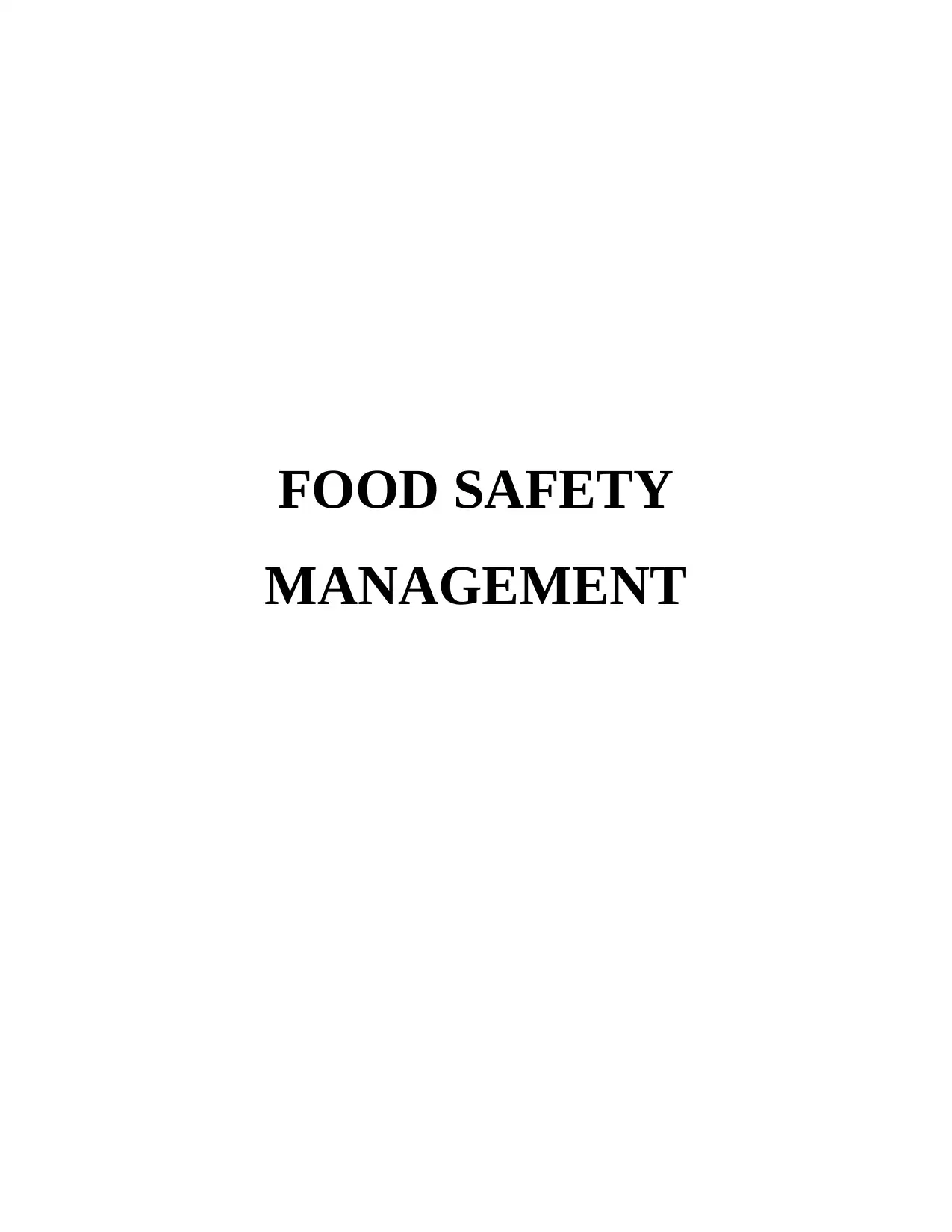
FOOD SAFETY
MANAGEMENT
MANAGEMENT
Paraphrase This Document
Need a fresh take? Get an instant paraphrase of this document with our AI Paraphraser
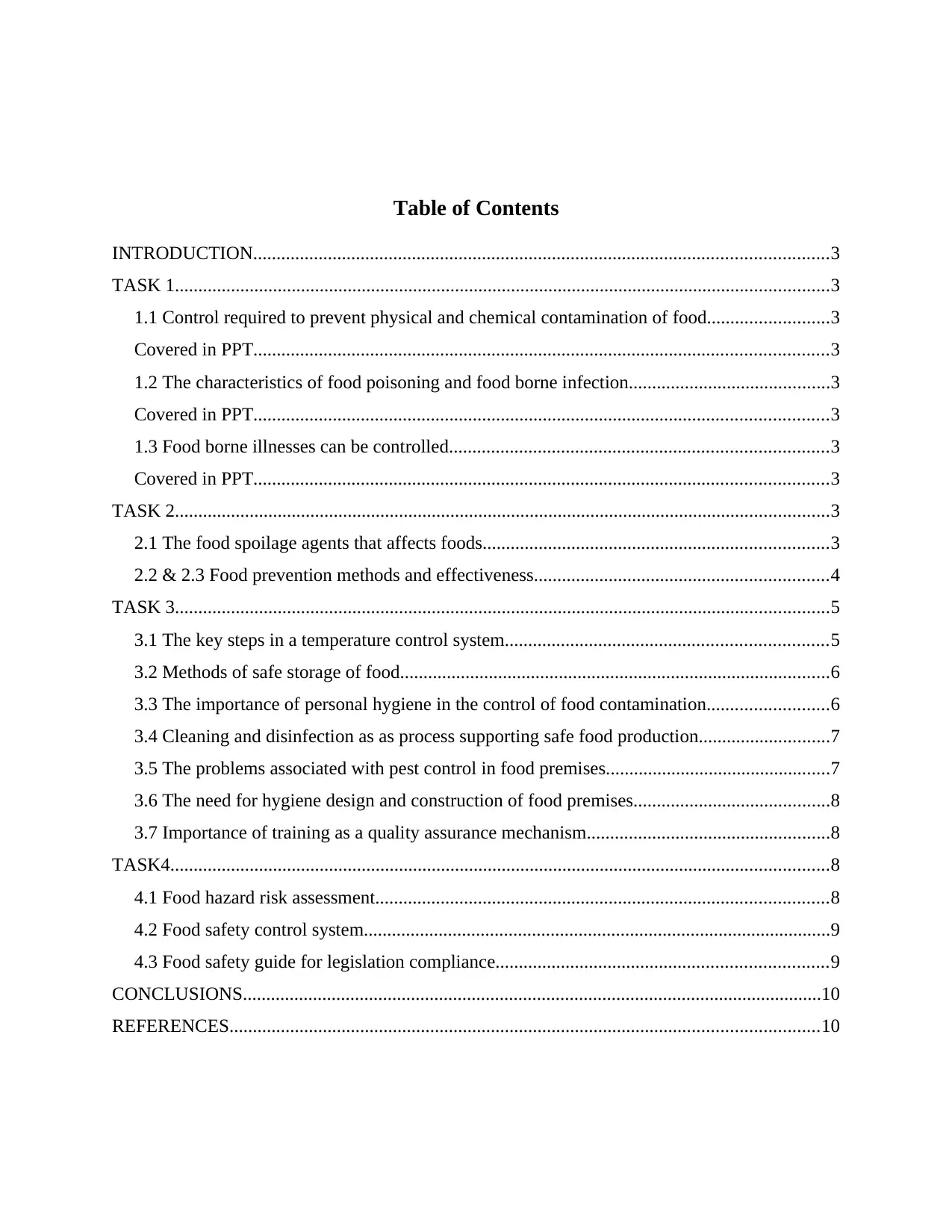
Table of Contents
INTRODUCTION...........................................................................................................................3
TASK 1............................................................................................................................................3
1.1 Control required to prevent physical and chemical contamination of food..........................3
Covered in PPT...........................................................................................................................3
1.2 The characteristics of food poisoning and food borne infection...........................................3
Covered in PPT...........................................................................................................................3
1.3 Food borne illnesses can be controlled.................................................................................3
Covered in PPT...........................................................................................................................3
TASK 2............................................................................................................................................3
2.1 The food spoilage agents that affects foods..........................................................................3
2.2 & 2.3 Food prevention methods and effectiveness...............................................................4
TASK 3............................................................................................................................................5
3.1 The key steps in a temperature control system.....................................................................5
3.2 Methods of safe storage of food............................................................................................6
3.3 The importance of personal hygiene in the control of food contamination..........................6
3.4 Cleaning and disinfection as as process supporting safe food production............................7
3.5 The problems associated with pest control in food premises................................................7
3.6 The need for hygiene design and construction of food premises..........................................8
3.7 Importance of training as a quality assurance mechanism....................................................8
TASK4.............................................................................................................................................8
4.1 Food hazard risk assessment.................................................................................................8
4.2 Food safety control system....................................................................................................9
4.3 Food safety guide for legislation compliance.......................................................................9
CONCLUSIONS............................................................................................................................10
REFERENCES..............................................................................................................................10
INTRODUCTION...........................................................................................................................3
TASK 1............................................................................................................................................3
1.1 Control required to prevent physical and chemical contamination of food..........................3
Covered in PPT...........................................................................................................................3
1.2 The characteristics of food poisoning and food borne infection...........................................3
Covered in PPT...........................................................................................................................3
1.3 Food borne illnesses can be controlled.................................................................................3
Covered in PPT...........................................................................................................................3
TASK 2............................................................................................................................................3
2.1 The food spoilage agents that affects foods..........................................................................3
2.2 & 2.3 Food prevention methods and effectiveness...............................................................4
TASK 3............................................................................................................................................5
3.1 The key steps in a temperature control system.....................................................................5
3.2 Methods of safe storage of food............................................................................................6
3.3 The importance of personal hygiene in the control of food contamination..........................6
3.4 Cleaning and disinfection as as process supporting safe food production............................7
3.5 The problems associated with pest control in food premises................................................7
3.6 The need for hygiene design and construction of food premises..........................................8
3.7 Importance of training as a quality assurance mechanism....................................................8
TASK4.............................................................................................................................................8
4.1 Food hazard risk assessment.................................................................................................8
4.2 Food safety control system....................................................................................................9
4.3 Food safety guide for legislation compliance.......................................................................9
CONCLUSIONS............................................................................................................................10
REFERENCES..............................................................................................................................10
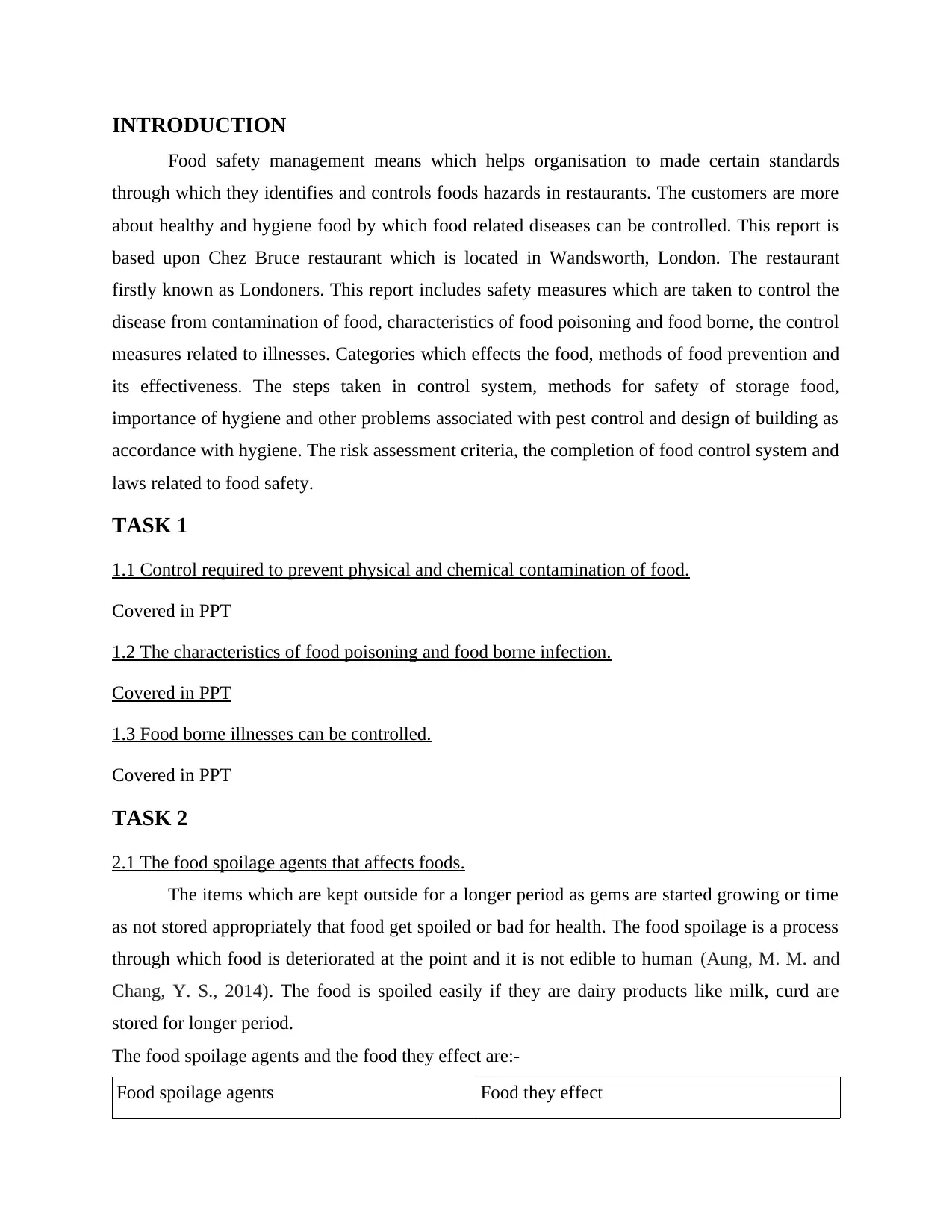
INTRODUCTION
Food safety management means which helps organisation to made certain standards
through which they identifies and controls foods hazards in restaurants. The customers are more
about healthy and hygiene food by which food related diseases can be controlled. This report is
based upon Chez Bruce restaurant which is located in Wandsworth, London. The restaurant
firstly known as Londoners. This report includes safety measures which are taken to control the
disease from contamination of food, characteristics of food poisoning and food borne, the control
measures related to illnesses. Categories which effects the food, methods of food prevention and
its effectiveness. The steps taken in control system, methods for safety of storage food,
importance of hygiene and other problems associated with pest control and design of building as
accordance with hygiene. The risk assessment criteria, the completion of food control system and
laws related to food safety.
TASK 1
1.1 Control required to prevent physical and chemical contamination of food.
Covered in PPT
1.2 The characteristics of food poisoning and food borne infection.
Covered in PPT
1.3 Food borne illnesses can be controlled.
Covered in PPT
TASK 2
2.1 The food spoilage agents that affects foods.
The items which are kept outside for a longer period as gems are started growing or time
as not stored appropriately that food get spoiled or bad for health. The food spoilage is a process
through which food is deteriorated at the point and it is not edible to human (Aung, M. M. and
Chang, Y. S., 2014). The food is spoiled easily if they are dairy products like milk, curd are
stored for longer period.
The food spoilage agents and the food they effect are:-
Food spoilage agents Food they effect
Food safety management means which helps organisation to made certain standards
through which they identifies and controls foods hazards in restaurants. The customers are more
about healthy and hygiene food by which food related diseases can be controlled. This report is
based upon Chez Bruce restaurant which is located in Wandsworth, London. The restaurant
firstly known as Londoners. This report includes safety measures which are taken to control the
disease from contamination of food, characteristics of food poisoning and food borne, the control
measures related to illnesses. Categories which effects the food, methods of food prevention and
its effectiveness. The steps taken in control system, methods for safety of storage food,
importance of hygiene and other problems associated with pest control and design of building as
accordance with hygiene. The risk assessment criteria, the completion of food control system and
laws related to food safety.
TASK 1
1.1 Control required to prevent physical and chemical contamination of food.
Covered in PPT
1.2 The characteristics of food poisoning and food borne infection.
Covered in PPT
1.3 Food borne illnesses can be controlled.
Covered in PPT
TASK 2
2.1 The food spoilage agents that affects foods.
The items which are kept outside for a longer period as gems are started growing or time
as not stored appropriately that food get spoiled or bad for health. The food spoilage is a process
through which food is deteriorated at the point and it is not edible to human (Aung, M. M. and
Chang, Y. S., 2014). The food is spoiled easily if they are dairy products like milk, curd are
stored for longer period.
The food spoilage agents and the food they effect are:-
Food spoilage agents Food they effect
⊘ This is a preview!⊘
Do you want full access?
Subscribe today to unlock all pages.

Trusted by 1+ million students worldwide
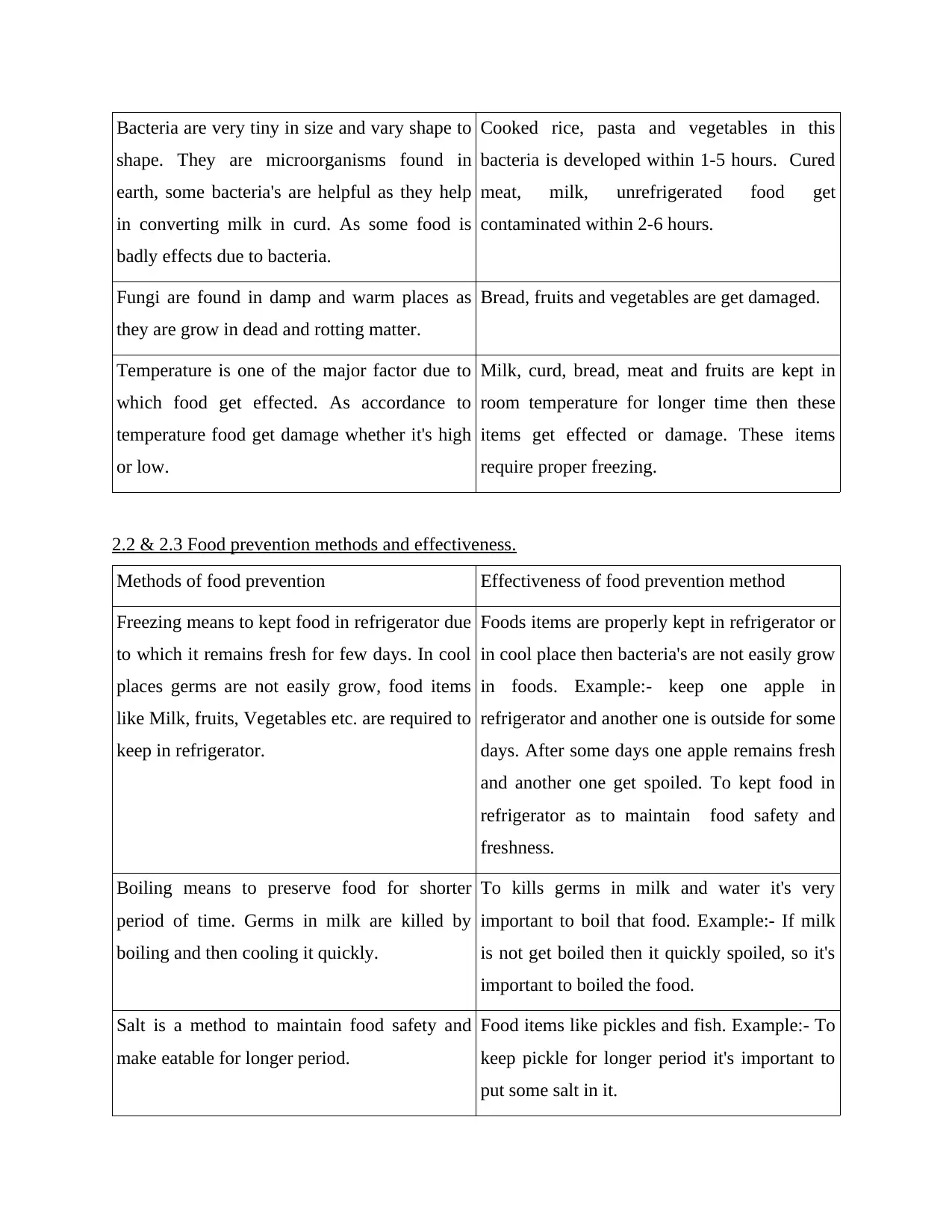
Bacteria are very tiny in size and vary shape to
shape. They are microorganisms found in
earth, some bacteria's are helpful as they help
in converting milk in curd. As some food is
badly effects due to bacteria.
Cooked rice, pasta and vegetables in this
bacteria is developed within 1-5 hours. Cured
meat, milk, unrefrigerated food get
contaminated within 2-6 hours.
Fungi are found in damp and warm places as
they are grow in dead and rotting matter.
Bread, fruits and vegetables are get damaged.
Temperature is one of the major factor due to
which food get effected. As accordance to
temperature food get damage whether it's high
or low.
Milk, curd, bread, meat and fruits are kept in
room temperature for longer time then these
items get effected or damage. These items
require proper freezing.
2.2 & 2.3 Food prevention methods and effectiveness.
Methods of food prevention Effectiveness of food prevention method
Freezing means to kept food in refrigerator due
to which it remains fresh for few days. In cool
places germs are not easily grow, food items
like Milk, fruits, Vegetables etc. are required to
keep in refrigerator.
Foods items are properly kept in refrigerator or
in cool place then bacteria's are not easily grow
in foods. Example:- keep one apple in
refrigerator and another one is outside for some
days. After some days one apple remains fresh
and another one get spoiled. To kept food in
refrigerator as to maintain food safety and
freshness.
Boiling means to preserve food for shorter
period of time. Germs in milk are killed by
boiling and then cooling it quickly.
To kills germs in milk and water it's very
important to boil that food. Example:- If milk
is not get boiled then it quickly spoiled, so it's
important to boiled the food.
Salt is a method to maintain food safety and
make eatable for longer period.
Food items like pickles and fish. Example:- To
keep pickle for longer period it's important to
put some salt in it.
shape. They are microorganisms found in
earth, some bacteria's are helpful as they help
in converting milk in curd. As some food is
badly effects due to bacteria.
Cooked rice, pasta and vegetables in this
bacteria is developed within 1-5 hours. Cured
meat, milk, unrefrigerated food get
contaminated within 2-6 hours.
Fungi are found in damp and warm places as
they are grow in dead and rotting matter.
Bread, fruits and vegetables are get damaged.
Temperature is one of the major factor due to
which food get effected. As accordance to
temperature food get damage whether it's high
or low.
Milk, curd, bread, meat and fruits are kept in
room temperature for longer time then these
items get effected or damage. These items
require proper freezing.
2.2 & 2.3 Food prevention methods and effectiveness.
Methods of food prevention Effectiveness of food prevention method
Freezing means to kept food in refrigerator due
to which it remains fresh for few days. In cool
places germs are not easily grow, food items
like Milk, fruits, Vegetables etc. are required to
keep in refrigerator.
Foods items are properly kept in refrigerator or
in cool place then bacteria's are not easily grow
in foods. Example:- keep one apple in
refrigerator and another one is outside for some
days. After some days one apple remains fresh
and another one get spoiled. To kept food in
refrigerator as to maintain food safety and
freshness.
Boiling means to preserve food for shorter
period of time. Germs in milk are killed by
boiling and then cooling it quickly.
To kills germs in milk and water it's very
important to boil that food. Example:- If milk
is not get boiled then it quickly spoiled, so it's
important to boiled the food.
Salt is a method to maintain food safety and
make eatable for longer period.
Food items like pickles and fish. Example:- To
keep pickle for longer period it's important to
put some salt in it.
Paraphrase This Document
Need a fresh take? Get an instant paraphrase of this document with our AI Paraphraser
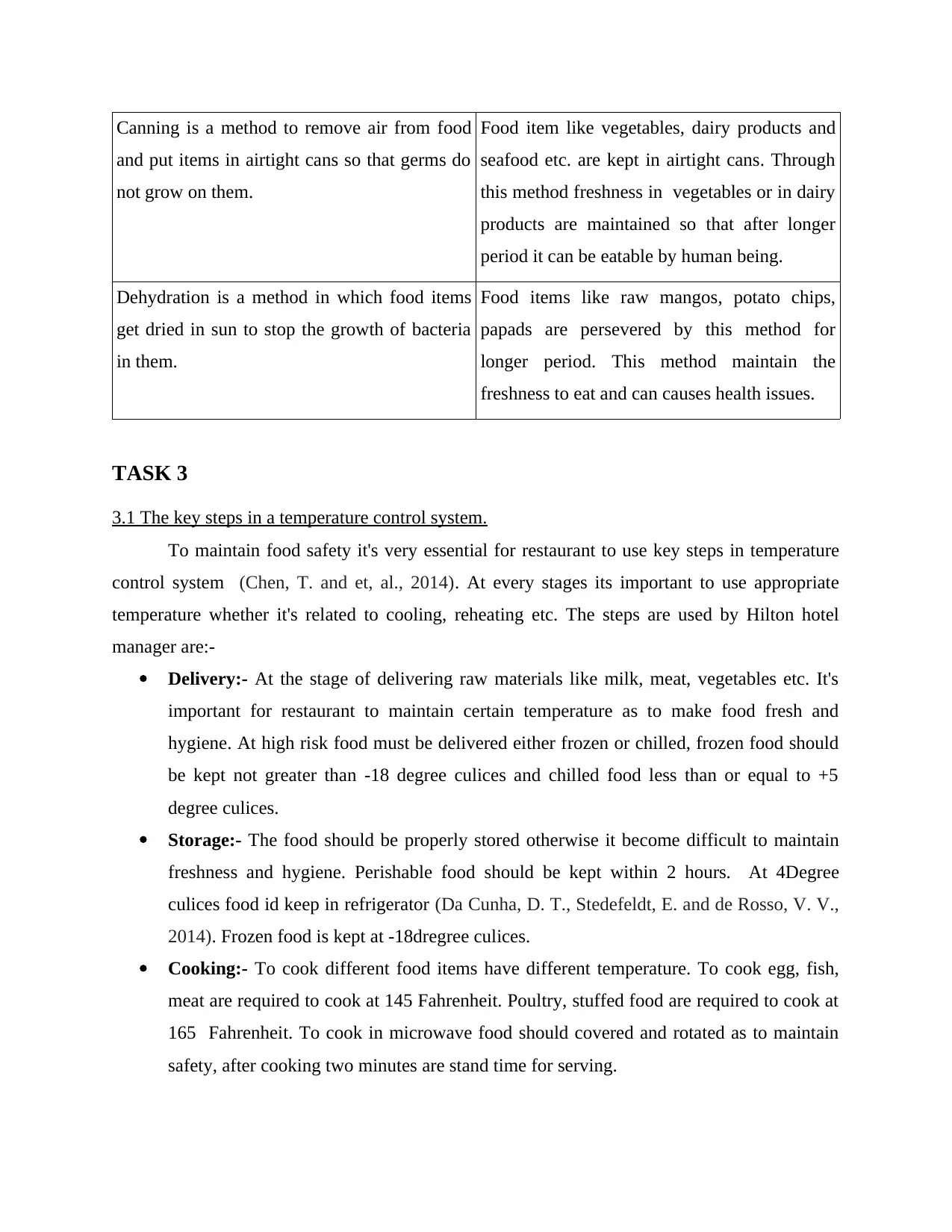
Canning is a method to remove air from food
and put items in airtight cans so that germs do
not grow on them.
Food item like vegetables, dairy products and
seafood etc. are kept in airtight cans. Through
this method freshness in vegetables or in dairy
products are maintained so that after longer
period it can be eatable by human being.
Dehydration is a method in which food items
get dried in sun to stop the growth of bacteria
in them.
Food items like raw mangos, potato chips,
papads are persevered by this method for
longer period. This method maintain the
freshness to eat and can causes health issues.
TASK 3
3.1 The key steps in a temperature control system.
To maintain food safety it's very essential for restaurant to use key steps in temperature
control system (Chen, T. and et, al., 2014). At every stages its important to use appropriate
temperature whether it's related to cooling, reheating etc. The steps are used by Hilton hotel
manager are:-
Delivery:- At the stage of delivering raw materials like milk, meat, vegetables etc. It's
important for restaurant to maintain certain temperature as to make food fresh and
hygiene. At high risk food must be delivered either frozen or chilled, frozen food should
be kept not greater than -18 degree culices and chilled food less than or equal to +5
degree culices.
Storage:- The food should be properly stored otherwise it become difficult to maintain
freshness and hygiene. Perishable food should be kept within 2 hours. At 4Degree
culices food id keep in refrigerator (Da Cunha, D. T., Stedefeldt, E. and de Rosso, V. V.,
2014). Frozen food is kept at -18dregree culices.
Cooking:- To cook different food items have different temperature. To cook egg, fish,
meat are required to cook at 145 Fahrenheit. Poultry, stuffed food are required to cook at
165 Fahrenheit. To cook in microwave food should covered and rotated as to maintain
safety, after cooking two minutes are stand time for serving.
and put items in airtight cans so that germs do
not grow on them.
Food item like vegetables, dairy products and
seafood etc. are kept in airtight cans. Through
this method freshness in vegetables or in dairy
products are maintained so that after longer
period it can be eatable by human being.
Dehydration is a method in which food items
get dried in sun to stop the growth of bacteria
in them.
Food items like raw mangos, potato chips,
papads are persevered by this method for
longer period. This method maintain the
freshness to eat and can causes health issues.
TASK 3
3.1 The key steps in a temperature control system.
To maintain food safety it's very essential for restaurant to use key steps in temperature
control system (Chen, T. and et, al., 2014). At every stages its important to use appropriate
temperature whether it's related to cooling, reheating etc. The steps are used by Hilton hotel
manager are:-
Delivery:- At the stage of delivering raw materials like milk, meat, vegetables etc. It's
important for restaurant to maintain certain temperature as to make food fresh and
hygiene. At high risk food must be delivered either frozen or chilled, frozen food should
be kept not greater than -18 degree culices and chilled food less than or equal to +5
degree culices.
Storage:- The food should be properly stored otherwise it become difficult to maintain
freshness and hygiene. Perishable food should be kept within 2 hours. At 4Degree
culices food id keep in refrigerator (Da Cunha, D. T., Stedefeldt, E. and de Rosso, V. V.,
2014). Frozen food is kept at -18dregree culices.
Cooking:- To cook different food items have different temperature. To cook egg, fish,
meat are required to cook at 145 Fahrenheit. Poultry, stuffed food are required to cook at
165 Fahrenheit. To cook in microwave food should covered and rotated as to maintain
safety, after cooking two minutes are stand time for serving.
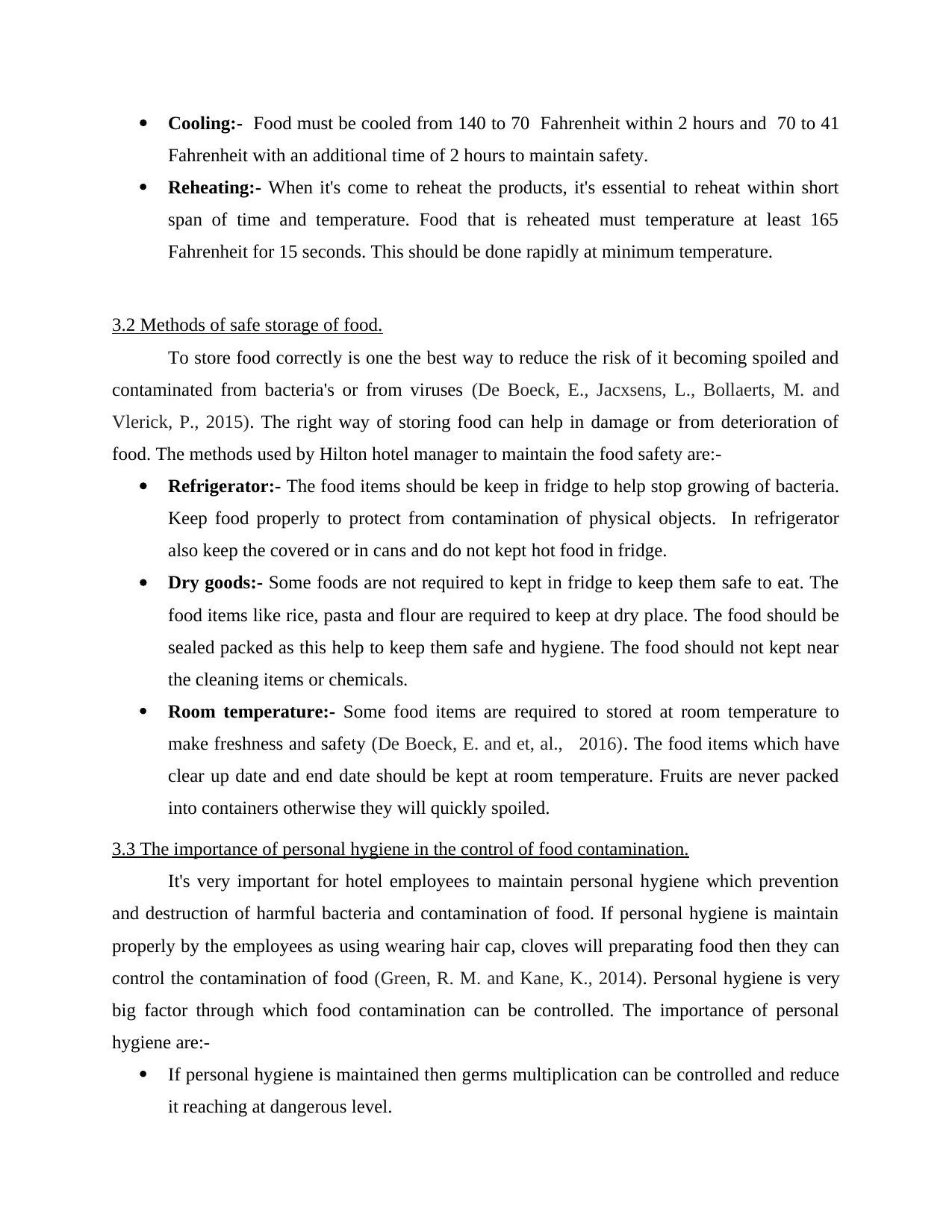
Cooling:- Food must be cooled from 140 to 70 Fahrenheit within 2 hours and 70 to 41
Fahrenheit with an additional time of 2 hours to maintain safety.
Reheating:- When it's come to reheat the products, it's essential to reheat within short
span of time and temperature. Food that is reheated must temperature at least 165
Fahrenheit for 15 seconds. This should be done rapidly at minimum temperature.
3.2 Methods of safe storage of food.
To store food correctly is one the best way to reduce the risk of it becoming spoiled and
contaminated from bacteria's or from viruses (De Boeck, E., Jacxsens, L., Bollaerts, M. and
Vlerick, P., 2015). The right way of storing food can help in damage or from deterioration of
food. The methods used by Hilton hotel manager to maintain the food safety are:-
Refrigerator:- The food items should be keep in fridge to help stop growing of bacteria.
Keep food properly to protect from contamination of physical objects. In refrigerator
also keep the covered or in cans and do not kept hot food in fridge.
Dry goods:- Some foods are not required to kept in fridge to keep them safe to eat. The
food items like rice, pasta and flour are required to keep at dry place. The food should be
sealed packed as this help to keep them safe and hygiene. The food should not kept near
the cleaning items or chemicals.
Room temperature:- Some food items are required to stored at room temperature to
make freshness and safety (De Boeck, E. and et, al., 2016). The food items which have
clear up date and end date should be kept at room temperature. Fruits are never packed
into containers otherwise they will quickly spoiled.
3.3 The importance of personal hygiene in the control of food contamination.
It's very important for hotel employees to maintain personal hygiene which prevention
and destruction of harmful bacteria and contamination of food. If personal hygiene is maintain
properly by the employees as using wearing hair cap, cloves will preparating food then they can
control the contamination of food (Green, R. M. and Kane, K., 2014). Personal hygiene is very
big factor through which food contamination can be controlled. The importance of personal
hygiene are:-
If personal hygiene is maintained then germs multiplication can be controlled and reduce
it reaching at dangerous level.
Fahrenheit with an additional time of 2 hours to maintain safety.
Reheating:- When it's come to reheat the products, it's essential to reheat within short
span of time and temperature. Food that is reheated must temperature at least 165
Fahrenheit for 15 seconds. This should be done rapidly at minimum temperature.
3.2 Methods of safe storage of food.
To store food correctly is one the best way to reduce the risk of it becoming spoiled and
contaminated from bacteria's or from viruses (De Boeck, E., Jacxsens, L., Bollaerts, M. and
Vlerick, P., 2015). The right way of storing food can help in damage or from deterioration of
food. The methods used by Hilton hotel manager to maintain the food safety are:-
Refrigerator:- The food items should be keep in fridge to help stop growing of bacteria.
Keep food properly to protect from contamination of physical objects. In refrigerator
also keep the covered or in cans and do not kept hot food in fridge.
Dry goods:- Some foods are not required to kept in fridge to keep them safe to eat. The
food items like rice, pasta and flour are required to keep at dry place. The food should be
sealed packed as this help to keep them safe and hygiene. The food should not kept near
the cleaning items or chemicals.
Room temperature:- Some food items are required to stored at room temperature to
make freshness and safety (De Boeck, E. and et, al., 2016). The food items which have
clear up date and end date should be kept at room temperature. Fruits are never packed
into containers otherwise they will quickly spoiled.
3.3 The importance of personal hygiene in the control of food contamination.
It's very important for hotel employees to maintain personal hygiene which prevention
and destruction of harmful bacteria and contamination of food. If personal hygiene is maintain
properly by the employees as using wearing hair cap, cloves will preparating food then they can
control the contamination of food (Green, R. M. and Kane, K., 2014). Personal hygiene is very
big factor through which food contamination can be controlled. The importance of personal
hygiene are:-
If personal hygiene is maintained then germs multiplication can be controlled and reduce
it reaching at dangerous level.
⊘ This is a preview!⊘
Do you want full access?
Subscribe today to unlock all pages.

Trusted by 1+ million students worldwide
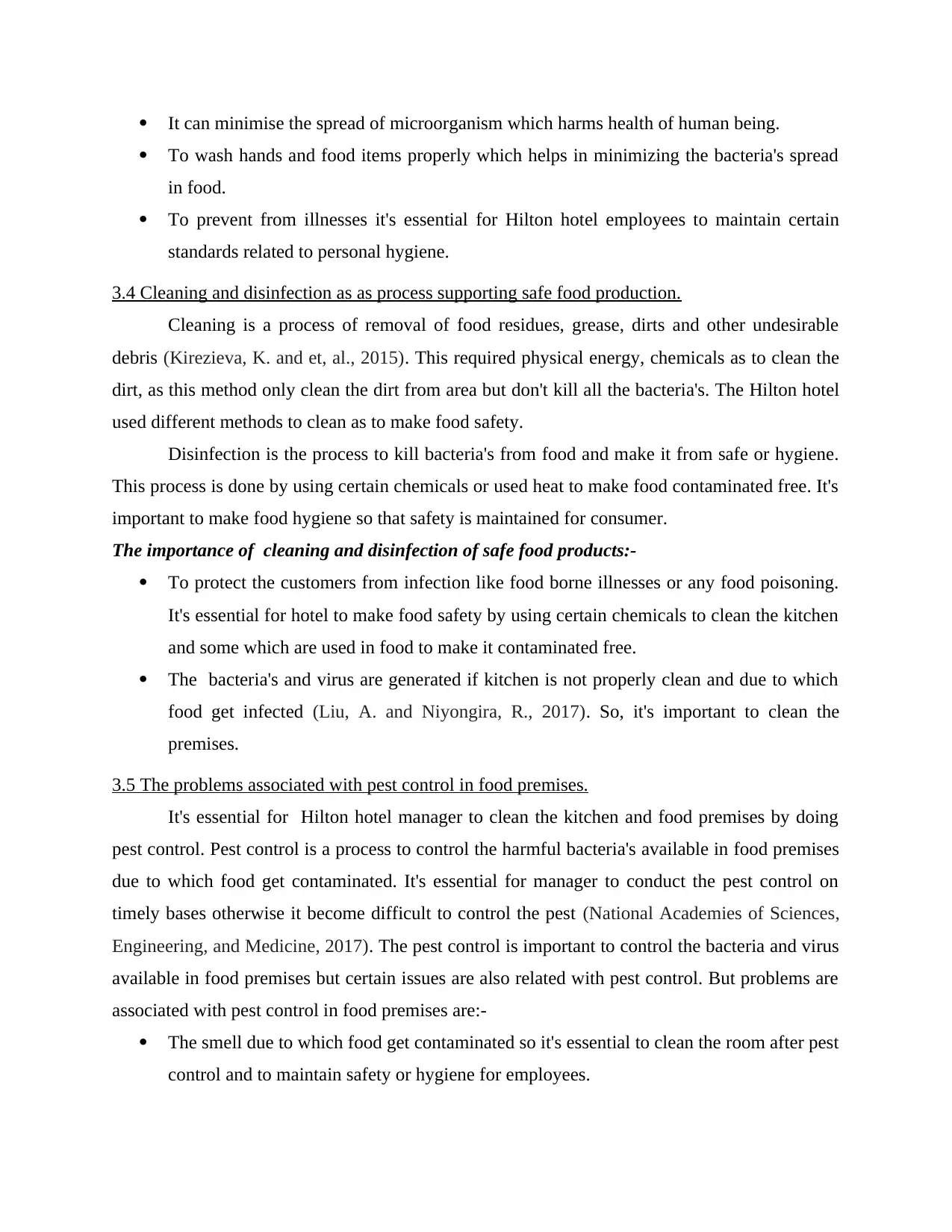
It can minimise the spread of microorganism which harms health of human being.
To wash hands and food items properly which helps in minimizing the bacteria's spread
in food.
To prevent from illnesses it's essential for Hilton hotel employees to maintain certain
standards related to personal hygiene.
3.4 Cleaning and disinfection as as process supporting safe food production.
Cleaning is a process of removal of food residues, grease, dirts and other undesirable
debris (Kirezieva, K. and et, al., 2015). This required physical energy, chemicals as to clean the
dirt, as this method only clean the dirt from area but don't kill all the bacteria's. The Hilton hotel
used different methods to clean as to make food safety.
Disinfection is the process to kill bacteria's from food and make it from safe or hygiene.
This process is done by using certain chemicals or used heat to make food contaminated free. It's
important to make food hygiene so that safety is maintained for consumer.
The importance of cleaning and disinfection of safe food products:-
To protect the customers from infection like food borne illnesses or any food poisoning.
It's essential for hotel to make food safety by using certain chemicals to clean the kitchen
and some which are used in food to make it contaminated free.
The bacteria's and virus are generated if kitchen is not properly clean and due to which
food get infected (Liu, A. and Niyongira, R., 2017). So, it's important to clean the
premises.
3.5 The problems associated with pest control in food premises.
It's essential for Hilton hotel manager to clean the kitchen and food premises by doing
pest control. Pest control is a process to control the harmful bacteria's available in food premises
due to which food get contaminated. It's essential for manager to conduct the pest control on
timely bases otherwise it become difficult to control the pest (National Academies of Sciences,
Engineering, and Medicine, 2017). The pest control is important to control the bacteria and virus
available in food premises but certain issues are also related with pest control. But problems are
associated with pest control in food premises are:-
The smell due to which food get contaminated so it's essential to clean the room after pest
control and to maintain safety or hygiene for employees.
To wash hands and food items properly which helps in minimizing the bacteria's spread
in food.
To prevent from illnesses it's essential for Hilton hotel employees to maintain certain
standards related to personal hygiene.
3.4 Cleaning and disinfection as as process supporting safe food production.
Cleaning is a process of removal of food residues, grease, dirts and other undesirable
debris (Kirezieva, K. and et, al., 2015). This required physical energy, chemicals as to clean the
dirt, as this method only clean the dirt from area but don't kill all the bacteria's. The Hilton hotel
used different methods to clean as to make food safety.
Disinfection is the process to kill bacteria's from food and make it from safe or hygiene.
This process is done by using certain chemicals or used heat to make food contaminated free. It's
important to make food hygiene so that safety is maintained for consumer.
The importance of cleaning and disinfection of safe food products:-
To protect the customers from infection like food borne illnesses or any food poisoning.
It's essential for hotel to make food safety by using certain chemicals to clean the kitchen
and some which are used in food to make it contaminated free.
The bacteria's and virus are generated if kitchen is not properly clean and due to which
food get infected (Liu, A. and Niyongira, R., 2017). So, it's important to clean the
premises.
3.5 The problems associated with pest control in food premises.
It's essential for Hilton hotel manager to clean the kitchen and food premises by doing
pest control. Pest control is a process to control the harmful bacteria's available in food premises
due to which food get contaminated. It's essential for manager to conduct the pest control on
timely bases otherwise it become difficult to control the pest (National Academies of Sciences,
Engineering, and Medicine, 2017). The pest control is important to control the bacteria and virus
available in food premises but certain issues are also related with pest control. But problems are
associated with pest control in food premises are:-
The smell due to which food get contaminated so it's essential to clean the room after pest
control and to maintain safety or hygiene for employees.
Paraphrase This Document
Need a fresh take? Get an instant paraphrase of this document with our AI Paraphraser
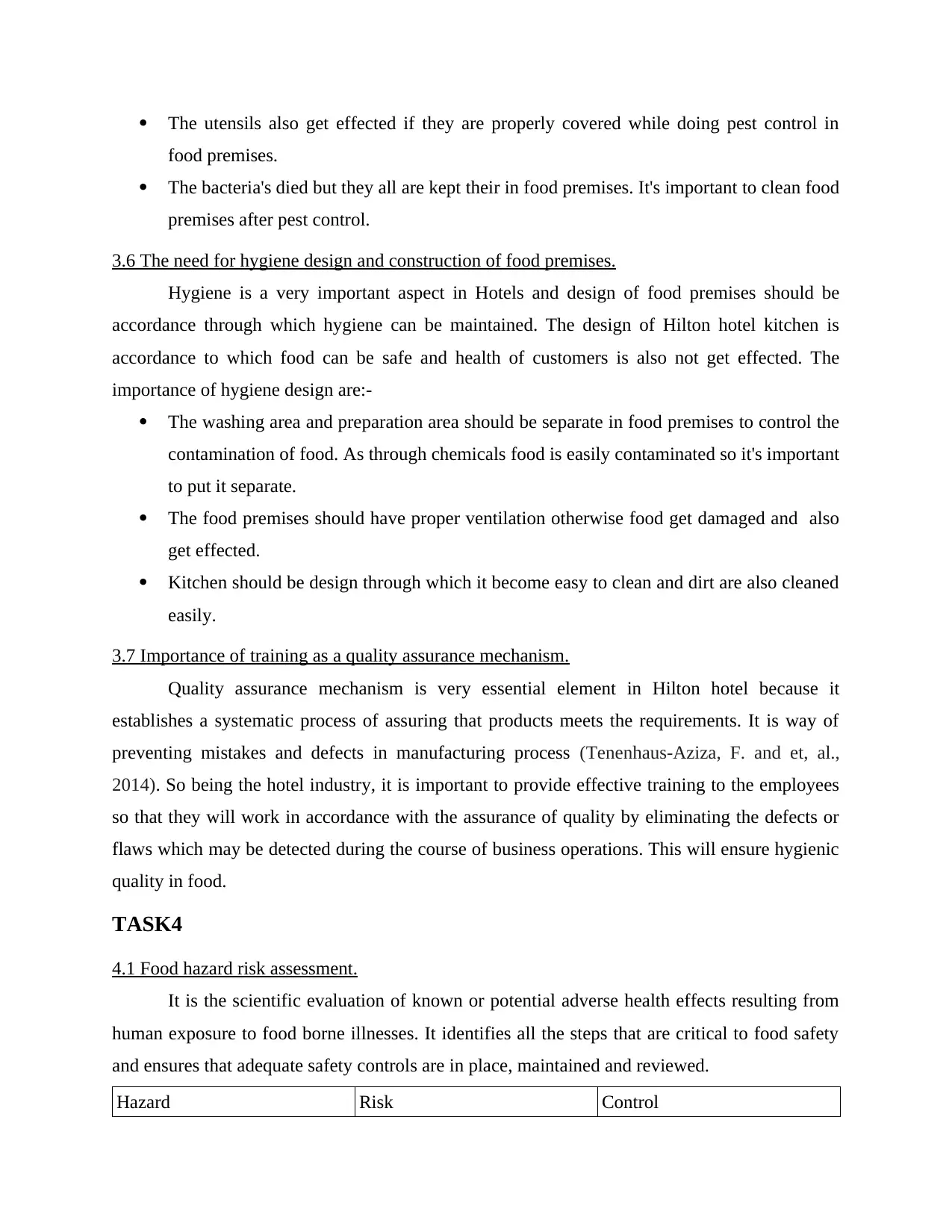
The utensils also get effected if they are properly covered while doing pest control in
food premises.
The bacteria's died but they all are kept their in food premises. It's important to clean food
premises after pest control.
3.6 The need for hygiene design and construction of food premises.
Hygiene is a very important aspect in Hotels and design of food premises should be
accordance through which hygiene can be maintained. The design of Hilton hotel kitchen is
accordance to which food can be safe and health of customers is also not get effected. The
importance of hygiene design are:-
The washing area and preparation area should be separate in food premises to control the
contamination of food. As through chemicals food is easily contaminated so it's important
to put it separate.
The food premises should have proper ventilation otherwise food get damaged and also
get effected.
Kitchen should be design through which it become easy to clean and dirt are also cleaned
easily.
3.7 Importance of training as a quality assurance mechanism.
Quality assurance mechanism is very essential element in Hilton hotel because it
establishes a systematic process of assuring that products meets the requirements. It is way of
preventing mistakes and defects in manufacturing process (Tenenhaus‐Aziza, F. and et, al.,
2014). So being the hotel industry, it is important to provide effective training to the employees
so that they will work in accordance with the assurance of quality by eliminating the defects or
flaws which may be detected during the course of business operations. This will ensure hygienic
quality in food.
TASK4
4.1 Food hazard risk assessment.
It is the scientific evaluation of known or potential adverse health effects resulting from
human exposure to food borne illnesses. It identifies all the steps that are critical to food safety
and ensures that adequate safety controls are in place, maintained and reviewed.
Hazard Risk Control
food premises.
The bacteria's died but they all are kept their in food premises. It's important to clean food
premises after pest control.
3.6 The need for hygiene design and construction of food premises.
Hygiene is a very important aspect in Hotels and design of food premises should be
accordance through which hygiene can be maintained. The design of Hilton hotel kitchen is
accordance to which food can be safe and health of customers is also not get effected. The
importance of hygiene design are:-
The washing area and preparation area should be separate in food premises to control the
contamination of food. As through chemicals food is easily contaminated so it's important
to put it separate.
The food premises should have proper ventilation otherwise food get damaged and also
get effected.
Kitchen should be design through which it become easy to clean and dirt are also cleaned
easily.
3.7 Importance of training as a quality assurance mechanism.
Quality assurance mechanism is very essential element in Hilton hotel because it
establishes a systematic process of assuring that products meets the requirements. It is way of
preventing mistakes and defects in manufacturing process (Tenenhaus‐Aziza, F. and et, al.,
2014). So being the hotel industry, it is important to provide effective training to the employees
so that they will work in accordance with the assurance of quality by eliminating the defects or
flaws which may be detected during the course of business operations. This will ensure hygienic
quality in food.
TASK4
4.1 Food hazard risk assessment.
It is the scientific evaluation of known or potential adverse health effects resulting from
human exposure to food borne illnesses. It identifies all the steps that are critical to food safety
and ensures that adequate safety controls are in place, maintained and reviewed.
Hazard Risk Control
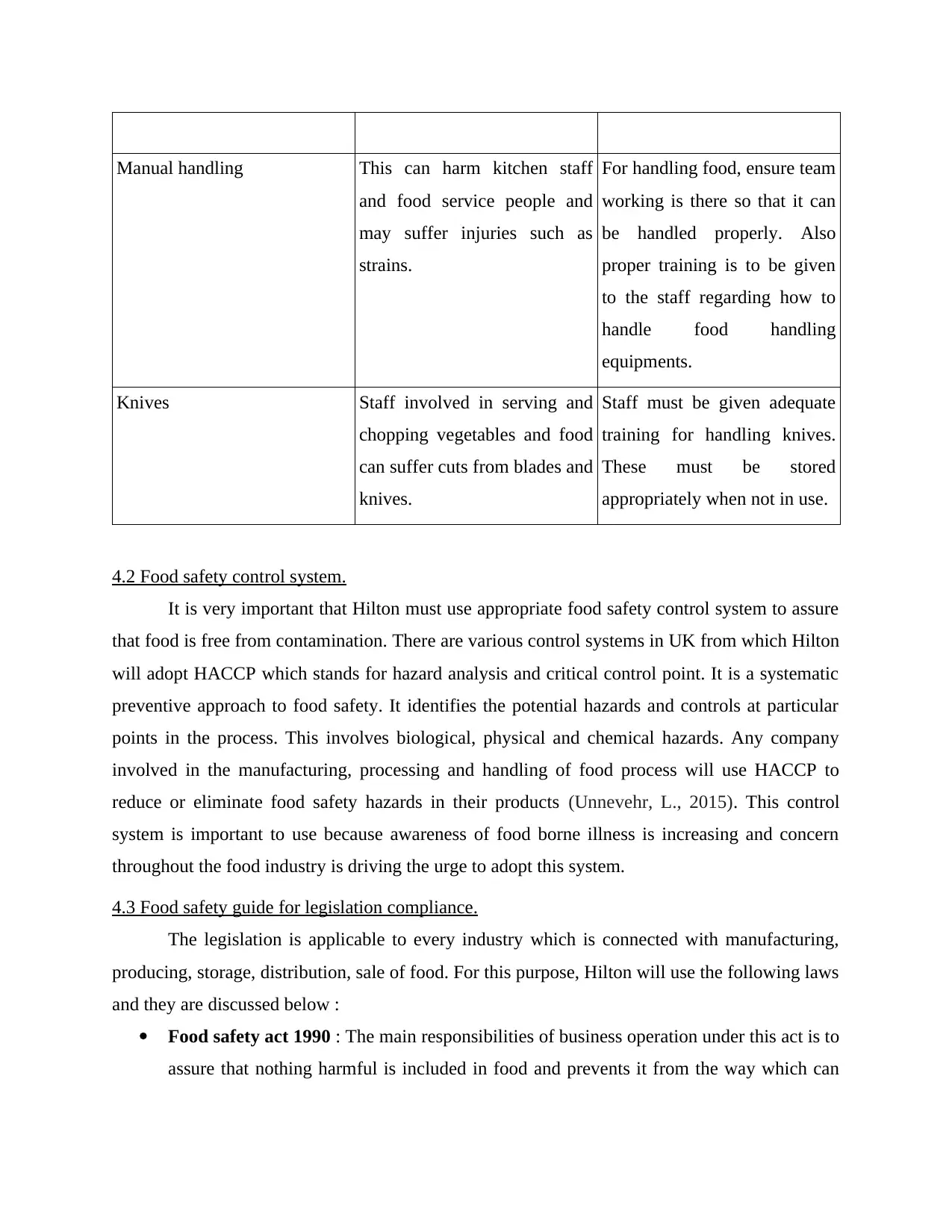
Manual handling This can harm kitchen staff
and food service people and
may suffer injuries such as
strains.
For handling food, ensure team
working is there so that it can
be handled properly. Also
proper training is to be given
to the staff regarding how to
handle food handling
equipments.
Knives Staff involved in serving and
chopping vegetables and food
can suffer cuts from blades and
knives.
Staff must be given adequate
training for handling knives.
These must be stored
appropriately when not in use.
4.2 Food safety control system.
It is very important that Hilton must use appropriate food safety control system to assure
that food is free from contamination. There are various control systems in UK from which Hilton
will adopt HACCP which stands for hazard analysis and critical control point. It is a systematic
preventive approach to food safety. It identifies the potential hazards and controls at particular
points in the process. This involves biological, physical and chemical hazards. Any company
involved in the manufacturing, processing and handling of food process will use HACCP to
reduce or eliminate food safety hazards in their products (Unnevehr, L., 2015). This control
system is important to use because awareness of food borne illness is increasing and concern
throughout the food industry is driving the urge to adopt this system.
4.3 Food safety guide for legislation compliance.
The legislation is applicable to every industry which is connected with manufacturing,
producing, storage, distribution, sale of food. For this purpose, Hilton will use the following laws
and they are discussed below :
Food safety act 1990 : The main responsibilities of business operation under this act is to
assure that nothing harmful is included in food and prevents it from the way which can
and food service people and
may suffer injuries such as
strains.
For handling food, ensure team
working is there so that it can
be handled properly. Also
proper training is to be given
to the staff regarding how to
handle food handling
equipments.
Knives Staff involved in serving and
chopping vegetables and food
can suffer cuts from blades and
knives.
Staff must be given adequate
training for handling knives.
These must be stored
appropriately when not in use.
4.2 Food safety control system.
It is very important that Hilton must use appropriate food safety control system to assure
that food is free from contamination. There are various control systems in UK from which Hilton
will adopt HACCP which stands for hazard analysis and critical control point. It is a systematic
preventive approach to food safety. It identifies the potential hazards and controls at particular
points in the process. This involves biological, physical and chemical hazards. Any company
involved in the manufacturing, processing and handling of food process will use HACCP to
reduce or eliminate food safety hazards in their products (Unnevehr, L., 2015). This control
system is important to use because awareness of food borne illness is increasing and concern
throughout the food industry is driving the urge to adopt this system.
4.3 Food safety guide for legislation compliance.
The legislation is applicable to every industry which is connected with manufacturing,
producing, storage, distribution, sale of food. For this purpose, Hilton will use the following laws
and they are discussed below :
Food safety act 1990 : The main responsibilities of business operation under this act is to
assure that nothing harmful is included in food and prevents it from the way which can
⊘ This is a preview!⊘
Do you want full access?
Subscribe today to unlock all pages.

Trusted by 1+ million students worldwide
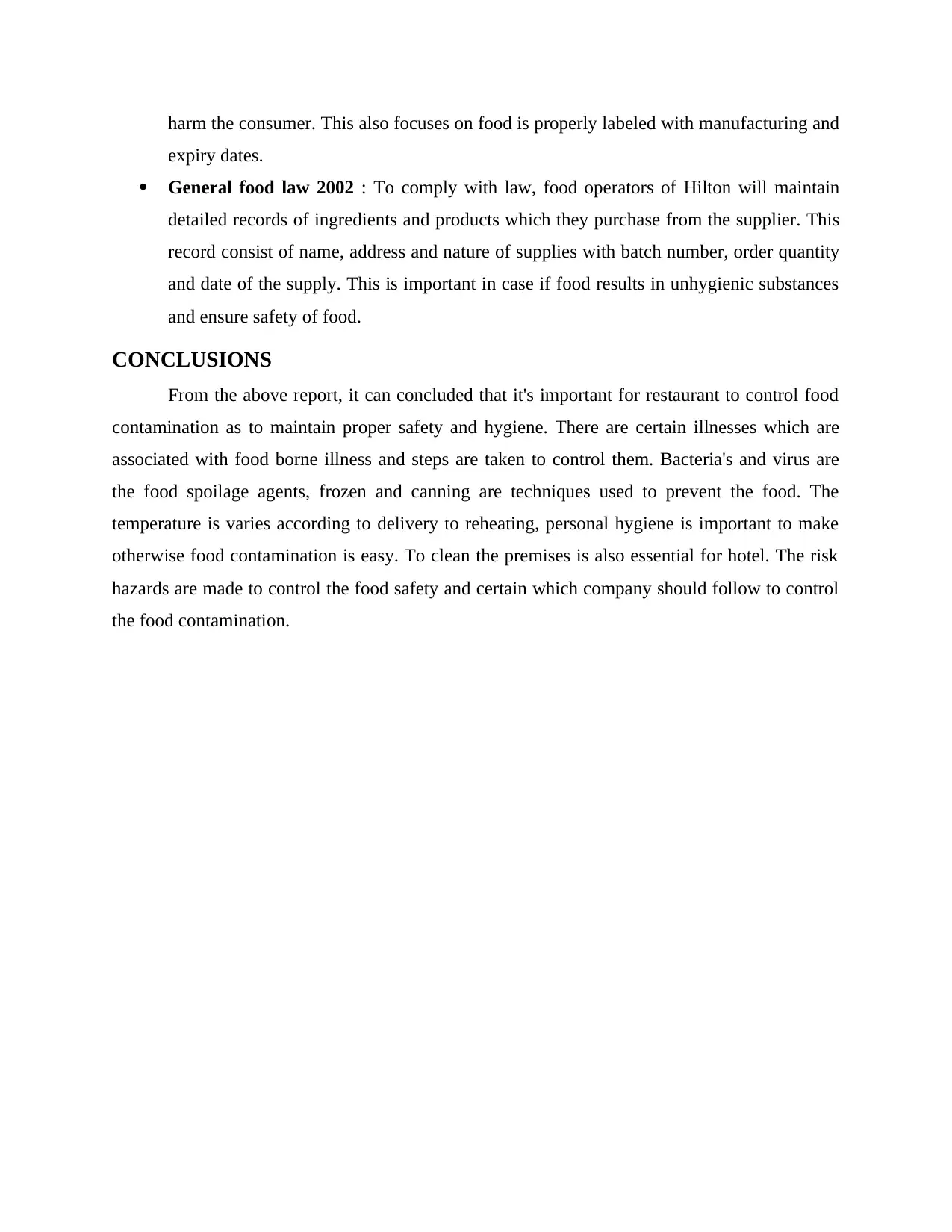
harm the consumer. This also focuses on food is properly labeled with manufacturing and
expiry dates.
General food law 2002 : To comply with law, food operators of Hilton will maintain
detailed records of ingredients and products which they purchase from the supplier. This
record consist of name, address and nature of supplies with batch number, order quantity
and date of the supply. This is important in case if food results in unhygienic substances
and ensure safety of food.
CONCLUSIONS
From the above report, it can concluded that it's important for restaurant to control food
contamination as to maintain proper safety and hygiene. There are certain illnesses which are
associated with food borne illness and steps are taken to control them. Bacteria's and virus are
the food spoilage agents, frozen and canning are techniques used to prevent the food. The
temperature is varies according to delivery to reheating, personal hygiene is important to make
otherwise food contamination is easy. To clean the premises is also essential for hotel. The risk
hazards are made to control the food safety and certain which company should follow to control
the food contamination.
expiry dates.
General food law 2002 : To comply with law, food operators of Hilton will maintain
detailed records of ingredients and products which they purchase from the supplier. This
record consist of name, address and nature of supplies with batch number, order quantity
and date of the supply. This is important in case if food results in unhygienic substances
and ensure safety of food.
CONCLUSIONS
From the above report, it can concluded that it's important for restaurant to control food
contamination as to maintain proper safety and hygiene. There are certain illnesses which are
associated with food borne illness and steps are taken to control them. Bacteria's and virus are
the food spoilage agents, frozen and canning are techniques used to prevent the food. The
temperature is varies according to delivery to reheating, personal hygiene is important to make
otherwise food contamination is easy. To clean the premises is also essential for hotel. The risk
hazards are made to control the food safety and certain which company should follow to control
the food contamination.
Paraphrase This Document
Need a fresh take? Get an instant paraphrase of this document with our AI Paraphraser
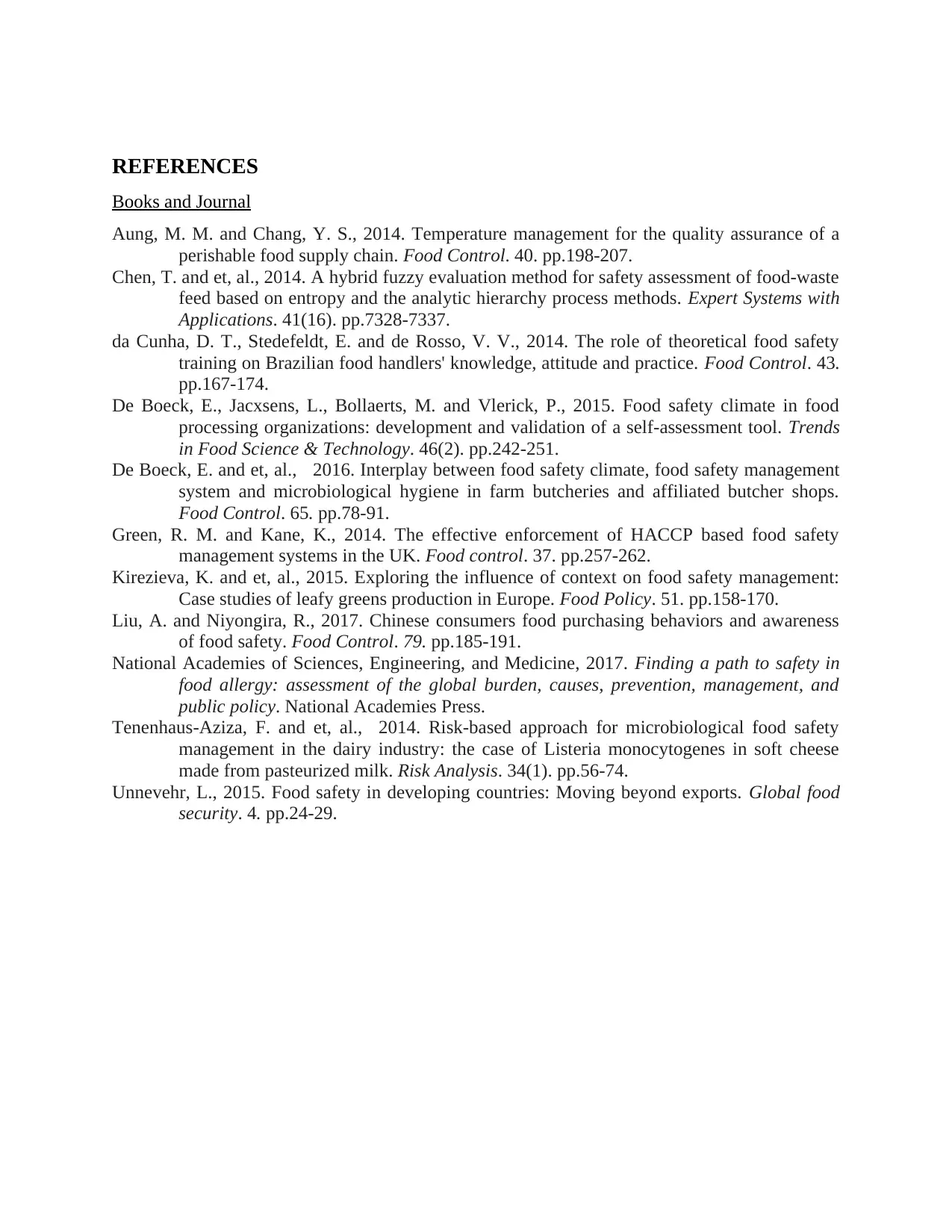
REFERENCES
Books and Journal
Aung, M. M. and Chang, Y. S., 2014. Temperature management for the quality assurance of a
perishable food supply chain. Food Control. 40. pp.198-207.
Chen, T. and et, al., 2014. A hybrid fuzzy evaluation method for safety assessment of food-waste
feed based on entropy and the analytic hierarchy process methods. Expert Systems with
Applications. 41(16). pp.7328-7337.
da Cunha, D. T., Stedefeldt, E. and de Rosso, V. V., 2014. The role of theoretical food safety
training on Brazilian food handlers' knowledge, attitude and practice. Food Control. 43.
pp.167-174.
De Boeck, E., Jacxsens, L., Bollaerts, M. and Vlerick, P., 2015. Food safety climate in food
processing organizations: development and validation of a self-assessment tool. Trends
in Food Science & Technology. 46(2). pp.242-251.
De Boeck, E. and et, al., 2016. Interplay between food safety climate, food safety management
system and microbiological hygiene in farm butcheries and affiliated butcher shops.
Food Control. 65. pp.78-91.
Green, R. M. and Kane, K., 2014. The effective enforcement of HACCP based food safety
management systems in the UK. Food control. 37. pp.257-262.
Kirezieva, K. and et, al., 2015. Exploring the influence of context on food safety management:
Case studies of leafy greens production in Europe. Food Policy. 51. pp.158-170.
Liu, A. and Niyongira, R., 2017. Chinese consumers food purchasing behaviors and awareness
of food safety. Food Control. 79. pp.185-191.
National Academies of Sciences, Engineering, and Medicine, 2017. Finding a path to safety in
food allergy: assessment of the global burden, causes, prevention, management, and
public policy. National Academies Press.
Tenenhaus‐Aziza, F. and et, al., 2014. Risk‐based approach for microbiological food safety
management in the dairy industry: the case of Listeria monocytogenes in soft cheese
made from pasteurized milk. Risk Analysis. 34(1). pp.56-74.
Unnevehr, L., 2015. Food safety in developing countries: Moving beyond exports. Global food
security. 4. pp.24-29.
Books and Journal
Aung, M. M. and Chang, Y. S., 2014. Temperature management for the quality assurance of a
perishable food supply chain. Food Control. 40. pp.198-207.
Chen, T. and et, al., 2014. A hybrid fuzzy evaluation method for safety assessment of food-waste
feed based on entropy and the analytic hierarchy process methods. Expert Systems with
Applications. 41(16). pp.7328-7337.
da Cunha, D. T., Stedefeldt, E. and de Rosso, V. V., 2014. The role of theoretical food safety
training on Brazilian food handlers' knowledge, attitude and practice. Food Control. 43.
pp.167-174.
De Boeck, E., Jacxsens, L., Bollaerts, M. and Vlerick, P., 2015. Food safety climate in food
processing organizations: development and validation of a self-assessment tool. Trends
in Food Science & Technology. 46(2). pp.242-251.
De Boeck, E. and et, al., 2016. Interplay between food safety climate, food safety management
system and microbiological hygiene in farm butcheries and affiliated butcher shops.
Food Control. 65. pp.78-91.
Green, R. M. and Kane, K., 2014. The effective enforcement of HACCP based food safety
management systems in the UK. Food control. 37. pp.257-262.
Kirezieva, K. and et, al., 2015. Exploring the influence of context on food safety management:
Case studies of leafy greens production in Europe. Food Policy. 51. pp.158-170.
Liu, A. and Niyongira, R., 2017. Chinese consumers food purchasing behaviors and awareness
of food safety. Food Control. 79. pp.185-191.
National Academies of Sciences, Engineering, and Medicine, 2017. Finding a path to safety in
food allergy: assessment of the global burden, causes, prevention, management, and
public policy. National Academies Press.
Tenenhaus‐Aziza, F. and et, al., 2014. Risk‐based approach for microbiological food safety
management in the dairy industry: the case of Listeria monocytogenes in soft cheese
made from pasteurized milk. Risk Analysis. 34(1). pp.56-74.
Unnevehr, L., 2015. Food safety in developing countries: Moving beyond exports. Global food
security. 4. pp.24-29.
1 out of 11
Related Documents
Your All-in-One AI-Powered Toolkit for Academic Success.
+13062052269
info@desklib.com
Available 24*7 on WhatsApp / Email
![[object Object]](/_next/static/media/star-bottom.7253800d.svg)
Unlock your academic potential
Copyright © 2020–2025 A2Z Services. All Rights Reserved. Developed and managed by ZUCOL.





